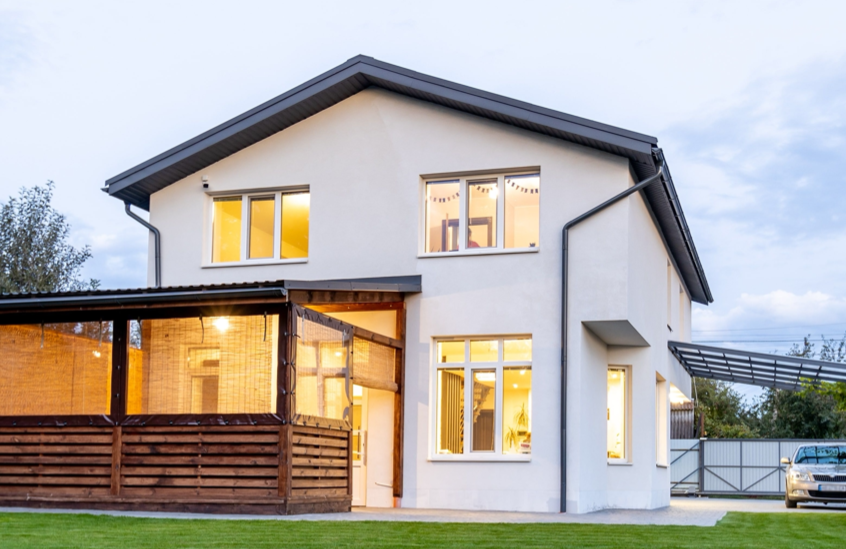|
Don't be fooled by an investor! They do not own your home! Call me today to figure out your options! 303.564.9637
 Pros and Cons Buying a Home for Airbnb Rentals 02 Buying a Home for Airbnb Rentals: Pros and Cons AirBnB investment properties broaden your network of renters from local residents to global travelers. Short-term Airbnb rentals can be a great way to generate passive income, but only if you have the right skills and strategies! Before purchasing a home to use for Airbnb, it’s important to know what to expect going into it. Buying a Home for Airbnb Rentals: Pros and Cons 03 Is AirBnB a Good Investment Strategy? As with any other property investment, your chances of success with Airbnb can vary. There isn’t a yes or no answer to the question of whether it’s a good strategy. You have to be smart about it! Several factors play into how much profit you can earn from Airbnb. You have to consider things like: Location Weather Time of year Surrounding competition Local regulations Management requirements Amenities and design Your lifestyle and schedule Investing in a home for Airbnb can be successful if you have enough time, skills, and resources to put toward it. Investors who thrive in the short-term leasing market often have entrepreneurship goals, investment skills, managerial experience, marketing know-how, and excellent communication. All these things will serve you and your renters through Airbnb. When done well, Airbnb hosts earn a yearly average of $41,000 to $80,000 from their rentals — sometimes more! But just like everything else in real estate, earnings depend on two main factors: location and timing. Celina and Joseph Quinones Real Estate Agent CELS HOMES REAL ESTATE LLC www.celshomes.com/ [email protected] Phone: 303-564-9637 , Office: 303-427-0777 License: 045670, CO Buying a Home for Airbnb Rentals: Pros and Cons 04 Pros of Owning an Airbnb Rental The main benefit of buying a home for short-term rental use is how lucrative it is. With Airbnb and its competitor platforms, you can expect these real estate benefits. Flexibility: With Airbnb, you have more control over the availability of your rental — as well as the tenants allowed to stay there. You can adjust rental costs depending on the time of year (such as vacation season or holidays), instead of locking into annual contracts. ROI Potential: It’s sometimes cheaper to furnish and set up Airbnb homes, meaning there’s a lower cost of entry. You’re also likely to get a good return on investment from steady monthly income in desirable locations. Host Protection: Depending on your region, Airbnb host protection plans offer up to $1 million in repairs for property losses. Instead of paying out of pocket for tenant damages, you’re financially protected by the company. Host Property Enjoyment: Opposite to long-term tenant leases, you can enjoy your own investment property when necessary. Whether it be personal vacations, special occasions, or renovation projects, you can block off rental availability to use the space for yourself. Celina and Joseph Quinones Real Estate Agent CELS HOMES REAL ESTATE LLC www.celshomes.com/ [email protected] Phone: 303-564-9637 , Office: 303-427-0777 License: 045670, CO Buying a Home for Airbnb Rentals: Pros and Cons 05 Cons of Owning an Airbnb Rental Owning an Airbnb rental can be highly profitable in ideal situations. However, it’s not all sunshine and rainbows for all parties involved. Here are some potential downsides to consider. More Responsibility: Investing in an Airbnb home requires a lot of responsibility. Not only do you need to purchase and set up the rental yourself, but you also need to maintain it year-round. You can hire a property manager to do that, which adds another layer of expenses. Legal Restrictions: Some jurisdictions have legal limits on short-term rentals. New York City, for example, banned whole-unit rentals that are less than 30 days. Understand your local regulations and know what’s possible before buying a home for Airbnb. Uncertainty: While a long-term property lease can ensure monthly income, Airbnb rental dates can be inconsistent. Depending on location, your rental might get booked only during summer but then remain vacant for the rest of the year. Additionally, it may take time to start earning money from Airbnb. Guests prefer to book homes with a history of good reviews on the app. Risk: A higher volume of guests with quick turnover dates can pose an increased risk to your property. Guests might be loud, break the rules, or potentially disrespect your rental. Celina and Joseph Quinones Real Estate Agent CELS HOMES REAL ESTATE LLC www.celshomes.com/ [email protected] Phone: 303-564-9637 , Office: 303-427-0777 License: 045670, CO Buying a Home for Airbnb Rentals: Pros and Cons 06 Buying an Investment Property for Airbnb Whether you already own a rental home or you’re new to buying investment properties, going the Airbnb route is a popular, realistic option. Typically, the best types of properties for Airbnb are: Vacation homes Properties in tourist areas Spaces with unique amenities such as a hot tub, great views, or quirky decor Entire homes or condos Experience-based properties like a treehouse or tiny home You also have to consider property financing options, renovation needs, interior design, and level of upkeep when buying for Airbnb. When looking to buy, it’s smart to get help from a real estate agent who specializes in short-term rental properties. Celina and Joseph Quinones Real Estate Agent CELS HOMES REAL ESTATE LLC www.celshomes.com/ [email protected] Phone: 303-564-9637 , Office: 303-427-0777 License: 045670, CO The bottom line is this: know your capabilities for buying and hosting an Airbnb If you enjoy long-term commitments, being involved in your property, meeting people from around the world, and providing a good experience, Airbnb might be for you! It can be a fun and rewarding way to earn consistent income. Interested in learning more about barndominiums? Reach out to one of our real estate experts! Whether you want to buy, build, or sell, we’re here to support you through all the requirements. A couple years ago we lost my grandma to covid. It was devastating to say the least. I don’t know for sure if I reached the right person but you may have been listed as a beneficiary for a recent death of a family member. I am here to tell you that you are not alone. The grief and heartache could be a lot but know that the pain and suffering is no more. I am here to help in any way I can. I have attached for your review an Estate planning guide that you may find helpful. Please feel free to reach out with any questions at all.
Cels Homes Real Estate will be Celebrating it's 10 year Anniversary next Year! We could not have done it without the people and community around us. We consider ourselves underdogs in Colorado but we do have heart!
In the highly competitive world of real estate, where industry giants dominate the market, it's often challenging for underdog companies to establish their presence and thrive. However, occasionally, a determined and resourceful company emerges, defying the odds and carving out its niche. This is the story of a remarkable underdog real estate company that has defied expectations and become a force to be reckoned with in the industry. 1 Humble Beginnings and Unwavering Vision: 2 Every success story starts with humble beginnings, and this underdog real estate company is no exception. Founded by a group of passionate individuals with a shared vision, this company began with limited resources but abundant determination. They believed in the power of providing exceptional customer service, cultivating trust, and embracing innovation. 3 Fostering a Customer-Centric Approach: 4 In an industry often criticized for its impersonal nature, this underdog real estate company differentiated itself by prioritizing its clients' needs above all else. By understanding the importance of building strong relationships and providing personalized attention, they successfully created a loyal customer base. The company went the extra mile to understand clients' unique requirements, offering tailored solutions that addressed their concerns and aspirations. 5 Embracing Technological Advancements: 6 Recognizing the ever-evolving nature of the real estate industry, this underdog company embraced technology as a catalyst for growth. They understood that by leveraging cutting-edge tools and platforms, they could streamline operations, enhance efficiency, and deliver exceptional services. From adopting customer relationship management (CRM) systems to utilizing virtual reality for property tours, they harnessed technology to provide a seamless and immersive experience to their clients. 7 Building a Team of Passionate Professionals: 8 A key factor behind the underdog company's success was its team of dedicated and passionate professionals. From skilled real estate agents to experienced property managers and marketing experts, they assembled a formidable workforce. The company fostered a culture of continuous learning and growth, investing in employee development programs and encouraging innovation and creativity. This cohesive team worked tirelessly to provide unparalleled support to their clients and constantly adapt to the ever-changing market conditions. 9 Niche Specialization and Market Differentiation: 10 Rather than trying to compete directly with the industry giants on all fronts, this underdog real estate company carved out a niche for itself. By focusing on an underserved market segment or geographical area, they were able to differentiate themselves from the competition. Their deep understanding of the local market dynamics, coupled with their niche expertise, positioned them as the go-to experts in their target market, attracting clients seeking specialized services. 11 Social Responsibility and Community Engagement: 12 Beyond business success, this underdog real estate company demonstrated a commitment to social responsibility and community engagement. They actively participated in local initiatives, supported charitable causes, and advocated for sustainable and ethical practices. This genuine dedication to making a positive impact resonated with clients who valued companies that shared their values. Conclusion: The journey of this underdog real estate company showcases the power of determination, customer-centricity, innovation, and a strong sense of purpose. Despite facing initial challenges and limited resources, they turned adversity into an opportunity for growth and emerged as a prominent player in the industry. By fostering strong relationships, embracing technology, focusing on specialization, and demonstrating social responsibility, this underdog company became an inspiring success story, proving that even in the most competitive landscapes, dreams can be realized with perseverance and a vision for excellence. If you are thinking of buying or selling here in Colorado make sure and give Cels Homes Real Estate a chance! We would love to help! Colorado, a picturesque state nestled in the heart of the Rocky Mountains, is renowned for its stunning landscapes, outdoor activities, and vibrant communities. However, like any other region, it is not immune to the challenges posed by crime. While Colorado boasts numerous safe and secure neighborhoods, it is essential to shed light on the issue of crime to understand its nature, causes, and the efforts being made to address it. In this article, we will delve into the crime landscape of Colorado, exploring its key facets and the initiatives being undertaken to foster a safer environment for its residents. 1 Crime Rates and Trends: When examining crime rates, it is important to consider the context and compare them to national averages. According to recent data, Colorado's crime rates are slightly higher than the national average. However, it is crucial to note that crime rates can vary significantly across different cities and regions within the state. Urban centers such as Denver, Colorado Springs, and Aurora tend to experience higher crime rates compared to rural areas. 2 Major Types of Crime: a. Property Crime: Property crimes, including burglary, theft, and motor vehicle theft, are among the most common offenses in Colorado. While property crime rates have been decreasing in recent years, it remains a significant concern for residents and law enforcement agencies. b. Violent Crime: Violent crime, though relatively less prevalent compared to property crimes, still poses a serious challenge. Crimes such as homicide, assault, and robbery demand attention from law enforcement and community leaders to ensure public safety. c. Drug-related Crime: Like many other states, Colorado faces challenges related to drug-related offenses. The legalization of recreational marijuana in 2014 has had both positive and negative implications, with potential links to increased drug-related crimes such as illegal cultivation, distribution, and impaired driving. 3 Contributing Factors: Understanding the contributing factors to crime is crucial in addressing and mitigating its impact. Several factors can influence crime rates, including: a. Socioeconomic Disparities: Economic inequality, poverty, and lack of access to educational and employment opportunities can contribute to higher crime rates in certain communities. b. Substance Abuse and Mental Health: Substance abuse and untreated mental health conditions often intersect with criminal behavior. Effective support systems, rehabilitation programs, and access to mental health resources are essential for addressing these underlying issues. c. Gang Activity: Urban areas in Colorado, particularly Denver, have struggled with gang-related activities. Targeted efforts to address the root causes of gang involvement and comprehensive community outreach can help mitigate the influence of gangs. 4 Crime Prevention and Community Engagement: To combat crime effectively, Colorado has implemented a range of preventive measures and community engagement initiatives: a. Law Enforcement: Police departments across the state have increased their presence in high-crime areas, implemented community policing strategies, and collaborated with community organizations to foster trust and cooperation. b. Education and Outreach: Schools, community centers, and nonprofits actively promote crime prevention and youth programs, aiming to steer young individuals away from criminal activities and provide them with positive opportunities. c. Neighborhood Watch Programs: Colorado residents actively participate in neighborhood watch programs, encouraging a sense of community vigilance and reporting suspicious activities to authorities promptly. d. Legislative Measures: Policymakers have enacted legislation to address specific crime-related concerns, such as enhancing penalties for certain offenses, implementing stricter gun control measures, and investing in rehabilitation programs for non-violent offenders. Conclusion: Colorado, like any other state, faces its share of crime-related challenges. While crime rates may vary across different cities and regions, it is essential to acknowledge the collective efforts being made by law enforcement agencies, community organizations, and policymakers to foster a safer environment. By addressing the contributing factors, implementing effective prevention strategies, and promoting community engagement  If you find yourself in the position where you are considering divorce as yourself this questions: Will the Grass be Greener on the other side? Most of the time we don't know the answer until we cross that bridge. When we take vows, we take them for life, for sickness and in health or richer or poorer however there are some genuine reasons that you should be able to pick up and leave: 1. Cheating-You caught your spouse cheating. 2. Abuse-Whether it is physically or mentally you have reason to pick up your things and leave. Some ways that you can fall back in love with each other may be: 1. Make Date night a priority 2. Make the relationship 100/100 not 20/80 not 40/60 but 100/100 3. Talk about it and don't go to sleep without your spouse or angry. If you can't seem to make it work after trying all exhausted efforts just do what's best. I am always here to talk. Sincerely, Your Realtor Celina Quinones
Click to set custom HTML
 With the recent news of a China Ballon floating in the US is it time for the Tik Tok to be banned from use in the USA? As a tik tok user myself I have found the App quite hypnotizing. Yes hypnotizing! Let's think about this. If our enemy can infiltrate from right inside of our homes by influencing us to spend countless hours on an app is this not a problem? I was recently a victim of being scammed via the app. Yes scammed. I spent countless hours requesting my account back from Tik tok to only get it back for a couple of days and have it taken again from me. I know I am not the only one this has happened to. When you lose access to say your email or even your bank account you can usually get it back within a couple hours. How is it an App is allowed to keep peoples personal information hostage in such a manner for months maybe even years? There is a huge data breach that is being allowed right now. The app is amazing yes, but we really have to dig deep and know the reality of it. Is it safe for the American people to be hypnotized in such a manner? If The US Government decides to Ban Tik Tok I would not be surprised. They know too much about us and it is not good. All I am saying a little taste of their own medicine may be good. What are your thoughts on this situation?  Your Guide to the Home Appraisal You’ve found your dream home and now it’s time to cross all your T's and dot all your I's before it’s all your own. And one of the first items on your closing checklist the home appraisal. So, what exactly is that? The home appraisal is essentially a value assessment of the home and property. It is conducted by a certified third party and is used to determine whether the home is priced appropriately. During a home appraisal, the appraiser conducts a complete visual inspection of the interior and exterior of the home. He or she factors in a variety of things, including the home’s floor plan functionality, condition, location, school district, fixtures, lot size, and more. An upward adjustment is generally made if the home has a deck, a view, or a large yard. The appraiser will also compare the home to several similar homes that were sold within the last six months in the area. The final report must include a street map showing the property and the ones’ compared, photographs of the interior and exterior, an explanation on how the square footage was calculated, market sales data, public land records, and more. After it is complete, the lender uses the information found to ensure that the property is worth the amount they are investing. This is a safe-guard for the lender as the home acts as collateral for the mortgage. If the buyer defaults on the mortgage and goes into foreclosure, the lender generally sells the home to recover the money borrowed. |
Cels HomesStaying up with all the new data that come in can be challenging but that is what we are here for Archives
July 2024
Categories |
||||||
Cels Homes Real Estate LLC
|




 RSS Feed
RSS Feed











